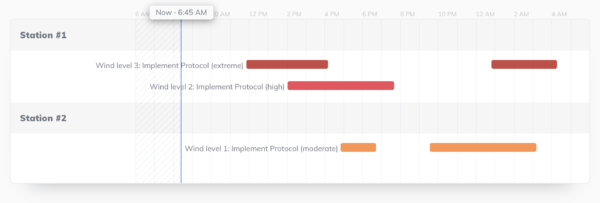It’s been wild weather across the globe this year. From flash floods to record-breaking wildfires, severe weather events have been coming thick and fast. But sometimes a lack of weather can also have a destabilizing effect on operations.
Europe – and the UK in particular – has been in the news recently due to soaring gas prices causing a number of energy companies to collapse.
The weather has been behind some of this crisis, with a lack of wind energy due to unusual weather patterns.
As energy demand is about to surge this winter, energy companies are facing a tough conundrum: how do they manage significant weather events that could lead to outages or price increases? And how can they keep their customers informed of the changing conditions?
A better understanding of weather can actually help energy companies avoid unexpected price hikes and better manage both supply and demand.
Unpredictable Energy Demand and Production
Energy demand is often inconsistent and can peak and fall quickly. Thanks to COVID lockdowns in 2020, energy demand fell to levels last seen in the 1950s, while windy spring weather meant that renewable energy production was high. At the start of 2021, it wasn’t as windy and production fell, but energy consumption and demand were still low. This lack of wind persisted into 2021, but energy demand was still low.
Wind turbine production has continued to decrease as the year has gone on in what has been one of the least windy summers since 1961. Wind-powered energy production has been so low in the UK that coal power stations are being used as a backup, even though they are due to be closed in three years. While the UK used no coal for more than 5,000 hours in 2020, warm weather systems mean that energy companies haven’t been able to rely on wind energy as much this year.
A lack of energy production, combined with low gas reserves, has meant that the price of gas has soared. These sky-high prices have also sparked concerns about potential power outages. In the age of social media, concerns about outages spread quickly and easily, and make for bad headlines for energy companies.
The energy crisis isn’t limited to Europe. Climate change and severe weather events have put a strain on a power grid that is already struggling to cope. In Texas, nearly half of the state’s wind energy capacity was lost during the peak of the freezing weather conditions in February.
During the wildfires in California in 2020, rolling blackouts meant electricity prices soared. Prices in locations near the Tahoe area and into Nevada spiked to thousands of dollars per megawatt-hour, much more than the typical cost of less than $100.
Customer Communication is Key
While news outlets have discussed the risk of power outages this winter, consumers have largely been left in the dark about the situation. Energy companies have failed to communicate the situation, whether to reassure their customers that the lack of wind or other weather conditions wouldn’t affect supply, or to alert them that there could be outages. Often, the first customers knew about any issues with their energy supply was through a news article or a massive bill in the mail.
Energy companies have already suffered badly in terms of reputation due to a lack of communication. When New Yorkers received a text message in June asking them to reduce energy usage and limit unnecessary usage of air conditioning due to potential energy outages, they took to social media to express their frustration. They were annoyed at the lack of advance notice while others asked why Times Square ads were still fully illuminated when they were being asked to turn off appliances. It was not a good example of how to keep customers happy while dealing with weather events.
How Weather Intelligence Helps Energy Companies
Weather intelligence enables you to let customers know about potential outages in advance and also helps you be more proactive in your decision making when it comes to incoming weather conditions.
It provides access to advanced historical, real-time, and future weather forecasting, so energy companies can better understand when a severe weather event (or lack of weather) is likely to affect energy production and energy demand. But consulting the forecast isn’t enough to manage energy demand and keep customers informed of when (or if) their supply will be affected and what they should do about it. You need to be able to understand historical weather patterns, forecast future weather, and be able to monitor additional risks.

Whenever you know that upcoming weather is likely to impact your operations, you can use your weather intelligence dashboard to automate alerts across your organization. This includes sending alerts to your customers to give them advance warning of the situation and communicate proactively.
For example, when you think that your customers’ energy supply might be affected due to lack of wind, you can send them an alert to update them on the situation rather than leaving them in the dark.
The ideal scenario is to avoid outages, but this isn’t always possible and often it’s outside of the energy companies’ control. But, with better data and weather intelligence, you can better manage incoming weather patterns, let customers know about potential outages in advance, improving satisfaction rates, and drive overall growth.














